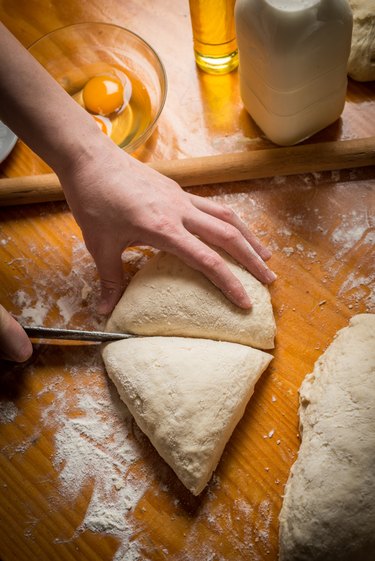
Yeast is a living single-celled fungus that is used in both bread and beer making. The word "yeast" is Sanskrit for "to seethe or boil." The species of yeast used in food is called Saccharomyces cerevisiae, a Latin name that means "sugar fungus." The organism is very common all around you, in the air and on the skin of fruits.
History
Video of the Day
Egyptians began using S. cerevisiae about 3,000 years ago, and yeast-leavened bread formed the basis of the European and Mediterranean diet for thousands of years. For the first several hundred years of its use, bakers grew yeast from sourdough starters, a mixture of grain and water where yeasts could ferment and grow. Bakers would remove a portion of this starter every day to make the bread, and would replenish it with more grain and water. In the 1850s, scientist Louis Pasteur studied the fungus and paved the way for the manufacturing process used today.
Video of the Day
Function
Yeast is a leavening agent, which means that it produces carbon dioxide bubbles that makes bread rise. Unlike baking powder or soda, which are chemical leaveners, the gas that yeast produces is a product of its feeding process. Yeast consumes the sugars in the bread dough and excretes carbon dioxide, which makes the dough puff up. The yeast also produces alcohol and some other byproducts, which produce the unique flavor of yeast breads. When you put your bread in the oven, the high heat kicks the yeast into overdrive, and the dough rises very quickly for a few minutes before the bread sets and the yeast dies.
Types
You can buy baking yeast in a cake or in a dry, granulated form. Because it contains about 70 percent moisture, cake yeast has a short shelf life. Dry yeast can be kept in the refrigerator for an extended period of time and used whenever you need it.
Baker's yeast is not the same as brewer's yeast or nutritional yeast, although they are all part of the S. cerevisiae family. Brewer's yeast is grown on hops, which are used in beermaking, and it has a bitter flavor. Nutritional yeast is grown on molasses and it has a sweeter flavor. Nutritional and brewer's yeast will never make bread rise because the fungus is killed during processing.
Benefits
S. cerevisiae is high in protein, fiber, B vitamins other than B-12 and folic acid. It may also improve immune function. Brewer's yeast is high in chromium. Research into the potential for yeast in modern medicinal treatments is ongoing. For example, Dr. Mamdooh Ghoneum of the Charles Drew University of Medicine and Science continues to study a possible role for baker's yeast in the treatment of cancer.
Cautions
Although it's fine to eat baked bread, never eat raw active yeast because these fungi are still alive and will continue to ferment in your digestive system, where they will eat your body's B-vitamins and produce gas.
- COFALEC: History
- Joy of Baking.com: Yeast
- Kitchen Dictionary: Yeast
- University of Maryland Medical Center: Brewer’s Yeast
- Diet and Health.net: Brewer’s Yeast Saccharomyces Cerevisiae
- Probiotic.org: Saccaromyces Cerevisiae
- Nutrition Research Center: How Can Baker’s Yeast be the Cure for Cancer?
- MoonDragon’s Health and Wellness: Yeast/Brewer’s Yeast